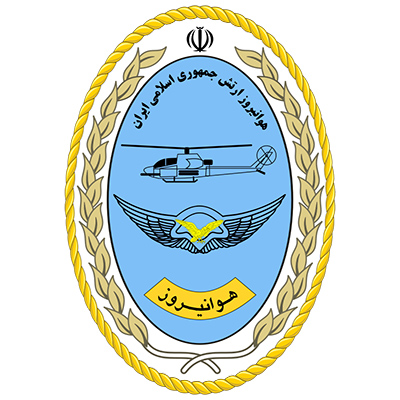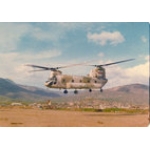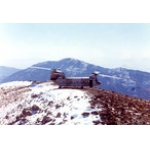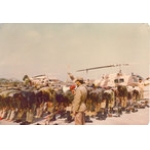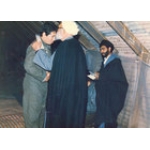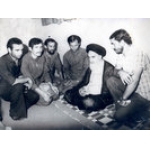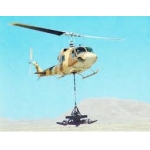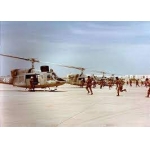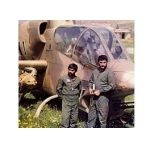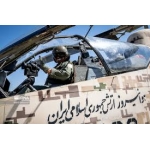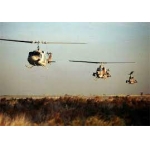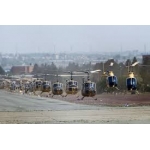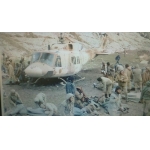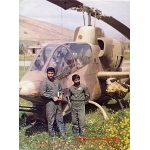Sites
Army Aviation (Havanirooz)
Mohsen Shir-Muhammad
125 دورہ
Havanirooz, or the Army Aviation of the Islamic Republic of Iran, played a major role in supporting Iranian military units during the Iran-Iraq War. It was established in 1962 with six single-engine Cessna aircraft and 14 pilots and technicians. Based in Qalemorghi Airport, Tehran, it later relocated to Isfahan. By 1965, its fleet had grown to 30 aircraft. At that time, Havanirooz was an aviation battalion consisting of a flight unit and a maintenance company. In 1966, 17 H-43 helicopters were added to its inventory. By 1971, with the acquisition of new helicopters, Havanirooz expanded, and gradually, the Isfahan pilot and technical education center (later known as Shahid Vatanpour Base) was established, in addition to three combat units in Kermanshah, Masjed Soleyman, and Kerman, and one general support unit in Isfahan.[1]
By 1978, Havanirooz operated 207 Cobra helicopters, 50 Bell-205s, 206 Bell-206s, 285 Bell-214s, and 90 Chinooks.[2] It also had two F-27 aircraft, two Falcon-20 jets, and four Commander aircraft for transport missions.[3]
After the Islamic Revolution and amid the internal crisis in Kurdistan, Havanirooz helicopters supported government forces. In early 1979, when separatist insurgents seized control of the main roads leading into Kurdistan, Havanirooz helicopters transported troops and ammunition to the 28th Division base in Sanandaj.[4] By early 1983, Havanirooz had logged about 60000 flight hours transporting troops and supplies in Kurdistan.[5]
When the Iran-Iraq War broke out, Havanirooz engaged Iraqi forces. Due to the lack of cohesion in the Iranian Army Ground Force early in the war, Havanirooz, alongside the Air Force, played a key role in halting the Iraqi army in the first days of the invasion in Khuzestan and western Iran.[6]
Throughout the series of operations to liberate Khuzestan, Havanirooz stood alongside the Army and the Islamic Revolutionary Guard Corps (IRGC). During Operation Thamen al-Aemah (as), which broke the siege of Abadan in September 1981, 46 helicopters including Cobras, Chinooks, and Bell-214s, logged 600 flight hours to support the Iranian forces.[7]
In November-December 1981, when Operation Tariq al-Qods was underway, 40 helicopters flew a combined 4862 hours, destroying enemy armor and equipment and transporting the Army and IRGC troops. Havanirooz also played a key role in Operation Fath al-Mobin and the liberation of Bostan in March 1982, striking enemy positions and relocating troops. In Operation Beit al-Muqaddas (March–April 1982), which led to the liberation of Khorramshahr, Havanirooz deployed 95 helicopters, which flew approximately 5180 hours to support Iranian troops.[8]
One of Havanirooz’s most extensive and impactful deployments during the Iran-Iraq War took place in Operation Kheibar (February 1984) in the Hawizeh Marshes (Hoor al-Azim). The main goal was to capture the Majnoon islands; however, all that standing water and wide-open terrain made it extremely difficult to keep the frontlines supplied as the distance and conditions had caused major logistical challenges. Therefore, for the first time, helicopters were used on a large scale to airlift troops.[9] A total of 98 helicopters flew 1291 hours, transporting 19400 Army and IRGC forces to the Majnoon islands. In the same area, during Operation Badr (March 1985), Havanirooz deployed 49 helicopters to move Iranian forces.[10] It participated in nearly every major operation of the Iran-Iraq War. Overall, Havanirooz helicopters flew approximately 300000 hours in support of 160 ground operations, transporting 70000 tons of military equipment and 270000 troops and evacuating 269000 wounded.[11] Also, its aircraft logged an additional 10000 flight hours during this period.[12]
162 Havanirooz personnel were martyred throughout the war, including 94 pilots. Among them were Mansour Vatanpour, Ali-Akbar Shiroodi, Ahmad Keshvari, Hamid-Reza Soheilian, and Nosratollah Asiayi.[13] 19 pilots and crew members were also captured by the enemy.[14]
After the war, Havanirooz continued to expand. The Zahedan Base was merged with the Kerman Combat Base, and new bases were established in Mashhad and Tabriz.[15] It has also been active in disaster relief operations, notably during the Manjil earthquake in 1990, when its helicopters played a major role in rescue efforts.[16]
During the war, Havanirooz was commanded by Colonel Ali Saadinam, Brigadier General Muhammad Hussain Jalali, and Brigadier General Mahmoud Ansari. Today, Brigadier General Qassem Khamoushi is the commander of Havanirooz.[17]
[1] Goruh-e Asatid-e Maarefe Jang, Maaref-e Jang (Teachings of War), Tehran, Entesharate Iran Sabz, 1393, Pp. 255, 256, 258.
[2] Darvishi, Farhad, Tajziye va Tahlile Jange Iran va Araq – Rishehaye Tahajom (Analysis of the Iran–Iraq War – Roots of the Invasion), Vol. 14, Tehran, Markaze Motaleat va Tahqiqat-e Jang, 1378, p. 95.
[3] Taqvaei, Babak, Yegane Baale Sabet-e Havanirooz (Fixed-Wing Unit of Army Aviation), Mahname Saf, No. 374, Esfand 1390 & Farvardin 1391, p. 43.
[4] Goruh-e Asatide Maarefe Jang, Ibid., p. 260.
[5] Qozzat, Rahman, Naqshe Havanirooz dar Dafa Ghaeleye Zed-e Enqelab az Mantaqe Kurdestan (Role of Army Aviation in Defeating Anti-revolutionary Elements in Kurdistan), Mahname Saf, No. 364, Esfand 1389 & Farvardin 1390, p. 79.
[6] Maarefe Jang, Ibid., Pp. 262–264.
[7] Ardeshirzadeh, Karim, Hamasehaye Mandegar-e Havanirooz dar Defa Muqaddas (Lasting Epics of Army Aviation in Sacred Defense), Tehran, Navid-e Tarrahan, 1388, p. 54.
[8] Ibid., Pp. 56, 64, 66, 71.
[9] Shir-Muhammad, Mohsen, Barfaraz-e Darya-ha – Negaahi be Tarikhe Havadarya va Hamaseye Eskadranhaaye Havanav, Balgard va Baale Sabet dar Jange Tahmili (Above the Seas – A Look at the History of Navy Air Operations and the Heroic Actions of Hovercraft, Helicopter, and Fixed-Wing Squadrons in the Imposed War), Tehran, Daftare Pajoheshhaye Nazari va Motaleat-e Rahbordiye Nirooye Daryayi, 1400, p. 221.
[10] Ardeshirzadeh, Karim, Ibid., Pp. 101, 107.
[11] Goruh-e Asatide Maarefe Jang, Ibid., p. 275.
[12] Ardeshirzadeh, Karim, Ibid., p. 175.
[13] Howzeh Honari Sazmane Tablighat-e Eslami, Sahifeye Parvaz – Zendeginameye Shohada-ye Havanirooz (The Book of Flight– Biographies of Army Aviation Martyrs), Tehran, Entesharate Soore Mehr, 1369, Pp. 5–7.
[14] Ardeshirzadeh, Karim, Ibid., Pp. 178–187.
[15] Goruh-e Asatide Maarefe Jang, Ibid., p. 260.
[16] Zare, Mahdi, Darsi az Zelzeleye Manjil (A Lesson from the Manjil Earthquake), Rooznameye Etemaad, No. 4671, 31 Khordad 1399, p. 3.
[17] Bashgahe Khabarnegarane Javan (Khabarnegarane Javan News Agency), 6 Mordad 1400, www.yjc.news/fa/news/7836761




